Samyam Rajbhandari
Fast and Accurate Causal Parallel Decoding using Jacobi Forcing
Dec 16, 2025Abstract:Multi-token generation has emerged as a promising paradigm for accelerating transformer-based large model inference. Recent efforts primarily explore diffusion Large Language Models (dLLMs) for parallel decoding to reduce inference latency. To achieve AR-level generation quality, many techniques adapt AR models into dLLMs to enable parallel decoding. However, they suffer from limited speedup compared to AR models due to a pretrain-to-posttrain mismatch. Specifically, the masked data distribution in post-training deviates significantly from the real-world data distribution seen during pretraining, and dLLMs rely on bidirectional attention, which conflicts with the causal prior learned during pretraining and hinders the integration of exact KV cache reuse. To address this, we introduce Jacobi Forcing, a progressive distillation paradigm where models are trained on their own generated parallel decoding trajectories, smoothly shifting AR models into efficient parallel decoders while preserving their pretrained causal inference property. The models trained under this paradigm, Jacobi Forcing Model, achieves 3.8x wall-clock speedup on coding and math benchmarks with minimal loss in performance. Based on Jacobi Forcing Models' trajectory characteristics, we introduce multi-block decoding with rejection recycling, which enables up to 4.5x higher token acceptance count per iteration and nearly 4.0x wall-clock speedup, effectively trading additional compute for lower inference latency. Our code is available at https://github.com/hao-ai-lab/JacobiForcing.
Arctic Inference with Shift Parallelism: Fast and Efficient Open Source Inference System for Enterprise AI
Jul 16, 2025Abstract:Inference is now the dominant AI workload, yet existing systems force trade-offs between latency, throughput, and cost. Arctic Inference, an open-source vLLM plugin from Snowflake AI Research, introduces Shift Parallelism, a dynamic parallelism strategy that adapts to real-world traffic while integrating speculative decoding, SwiftKV compute reduction, and optimized embedding inference. It achieves up to 3.4 times faster request completion, 1.75 times faster generation, and 1.6M tokens/sec per GPU for embeddings, outperforming both latency- and throughput-optimized deployments. Already powering Snowflake Cortex AI, Arctic Inference delivers state-of-the-art, cost-effective inference for enterprise AI and is now available to the community.
SwiftKV: Fast Prefill-Optimized Inference with Knowledge-Preserving Model Transformation
Oct 04, 2024Abstract:LLM inference for popular enterprise use cases, such as summarization, RAG, and code-generation, typically observes orders of magnitude longer prompt lengths than generation lengths. This characteristic leads to high cost of prefill and increased response latency. In this paper, we present SwiftKV, a novel model transformation and distillation procedure specifically designed to reduce the time and cost of processing prompt tokens while preserving high quality of generated tokens. SwiftKV combines three key mechanisms: i) SingleInputKV, which prefills later layers' KV cache using a much earlier layer's output, allowing prompt tokens to skip much of the model computation, ii) AcrossKV, which merges the KV caches of neighboring layers to reduce the memory footprint and support larger batch size for higher throughput, and iii) a knowledge-preserving distillation procedure that can adapt existing LLMs for SwiftKV with minimal accuracy impact and low compute and data requirement. For Llama-3.1-8B and 70B, SwiftKV reduces the compute requirement of prefill by 50% and the memory requirement of the KV cache by 62.5% while incurring minimum quality degradation across a wide range of tasks. In the end-to-end inference serving using an optimized vLLM implementation, SwiftKV realizes up to 2x higher aggregate throughput and 60% lower time per output token. It can achieve a staggering 560 TFlops/GPU of normalized inference throughput, which translates to 16K tokens/s for Llama-3.1-70B in 16-bit precision on 4x H100 GPUs.
DeepSpeed-FastGen: High-throughput Text Generation for LLMs via MII and DeepSpeed-Inference
Jan 09, 2024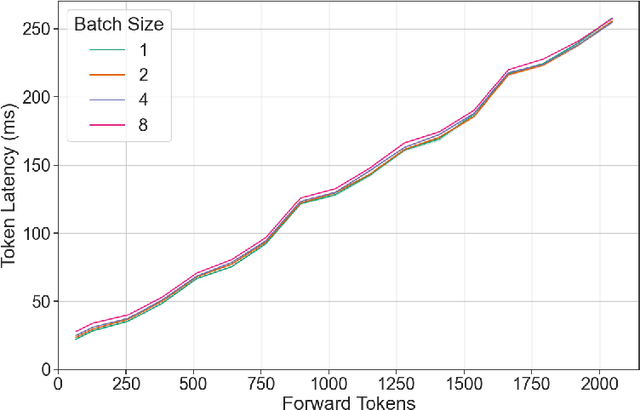
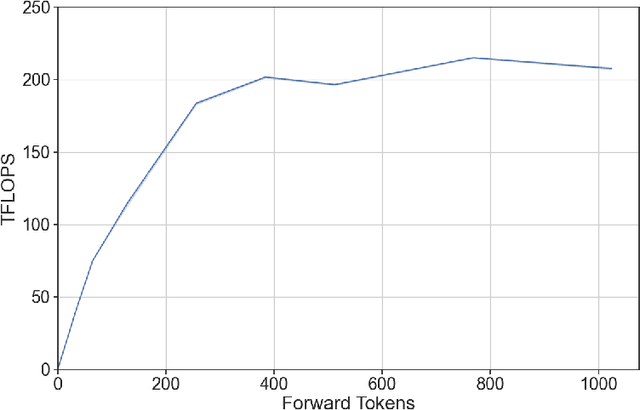
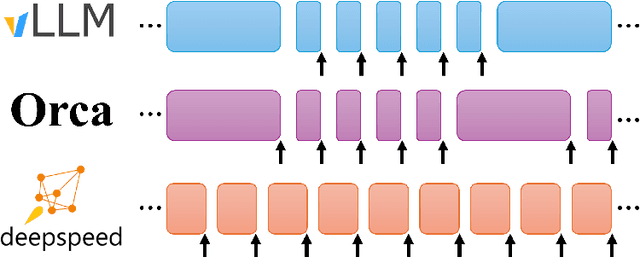

Abstract:The deployment and scaling of large language models (LLMs) have become critical as they permeate various applications, demanding high-throughput and low-latency serving systems. Existing frameworks struggle to balance these requirements, especially for workloads with long prompts. This paper introduces DeepSpeed-FastGen, a system that employs Dynamic SplitFuse, a novel prompt and generation composition strategy, to deliver up to 2.3x higher effective throughput, 2x lower latency on average, and up to 3.7x lower (token-level) tail latency, compared to state-of-the-art systems like vLLM. We leverage a synergistic combination of DeepSpeed-MII and DeepSpeed-Inference to provide an efficient and easy-to-use serving system for LLMs. DeepSpeed-FastGen's advanced implementation supports a range of models and offers both non-persistent and persistent deployment options, catering to diverse user scenarios from interactive sessions to long-running applications. We present a detailed benchmarking methodology, analyze the performance through latency-throughput curves, and investigate scalability via load balancing. Our evaluations demonstrate substantial improvements in throughput and latency across various models and hardware configurations. We discuss our roadmap for future enhancements, including broader model support and new hardware backends. The DeepSpeed-FastGen code is readily available for community engagement and contribution.
DeepSpeed-VisualChat: Multi-Round Multi-Image Interleave Chat via Multi-Modal Causal Attention
Sep 29, 2023



Abstract:Most of the existing multi-modal models, hindered by their incapacity to adeptly manage interleaved image-and-text inputs in multi-image, multi-round dialogues, face substantial constraints in resource allocation for training and data accessibility, impacting their adaptability and scalability across varied interaction realms. To address this, we present the DeepSpeed-VisualChat framework, designed to optimize Large Language Models (LLMs) by incorporating multi-modal capabilities, with a focus on enhancing the proficiency of Large Vision and Language Models in handling interleaved inputs. Our framework is notable for (1) its open-source support for multi-round and multi-image dialogues, (2) introducing an innovative multi-modal causal attention mechanism, and (3) utilizing data blending techniques on existing datasets to assure seamless interactions in multi-round, multi-image conversations. Compared to existing frameworks, DeepSpeed-VisualChat shows superior scalability up to 70B parameter language model size, representing a significant advancement in multi-modal language models and setting a solid foundation for future explorations.
DeepSpeed Ulysses: System Optimizations for Enabling Training of Extreme Long Sequence Transformer Models
Sep 25, 2023



Abstract:Computation in a typical Transformer-based large language model (LLM) can be characterized by batch size, hidden dimension, number of layers, and sequence length. Until now, system works for accelerating LLM training have focused on the first three dimensions: data parallelism for batch size, tensor parallelism for hidden size and pipeline parallelism for model depth or layers. These widely studied forms of parallelism are not targeted or optimized for long sequence Transformer models. Given practical application needs for long sequence LLM, renewed attentions are being drawn to sequence parallelism. However, existing works in sequence parallelism are constrained by memory-communication inefficiency, limiting their scalability to long sequence large models. In this work, we introduce DeepSpeed-Ulysses, a novel, portable and effective methodology for enabling highly efficient and scalable LLM training with extremely long sequence length. DeepSpeed-Ulysses at its core partitions input data along the sequence dimension and employs an efficient all-to-all collective communication for attention computation. Theoretical communication analysis shows that whereas other methods incur communication overhead as sequence length increases, DeepSpeed-Ulysses maintains constant communication volume when sequence length and compute devices are increased proportionally. Furthermore, experimental evaluations show that DeepSpeed-Ulysses trains 2.5X faster with 4X longer sequence length than the existing method SOTA baseline.
DeepSpeed-Chat: Easy, Fast and Affordable RLHF Training of ChatGPT-like Models at All Scales
Aug 02, 2023
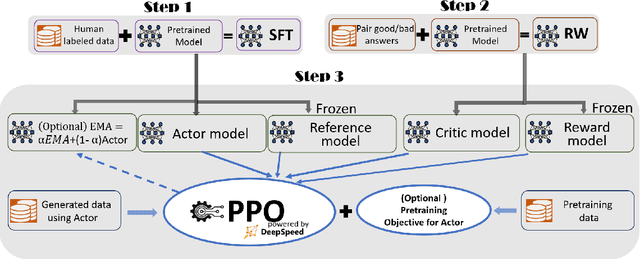

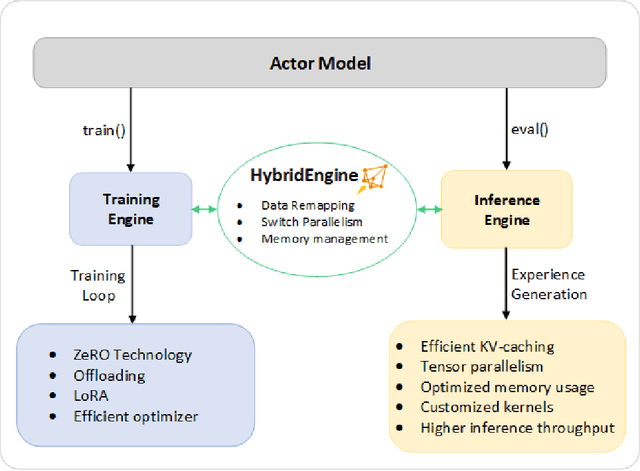
Abstract:ChatGPT-like models have revolutionized various applications in artificial intelligence, from summarization and coding to translation, matching or even surpassing human performance. However, the current landscape lacks an accessible, efficient, and cost-effective end-to-end RLHF (Reinforcement Learning with Human Feedback) training pipeline for these powerful models, particularly when training at the scale of billions of parameters. This paper introduces DeepSpeed-Chat, a novel system that democratizes RLHF training, making it accessible to the AI community. DeepSpeed-Chat offers three key capabilities: an easy-to-use training and inference experience for ChatGPT-like models, a DeepSpeed-RLHF pipeline that replicates the training pipeline from InstructGPT, and a robust DeepSpeed-RLHF system that combines various optimizations for training and inference in a unified way. The system delivers unparalleled efficiency and scalability, enabling training of models with hundreds of billions of parameters in record time and at a fraction of the cost. With this development, DeepSpeed-Chat paves the way for broader access to advanced RLHF training, even for data scientists with limited resources, thereby fostering innovation and further development in the field of AI.
ZeRO++: Extremely Efficient Collective Communication for Giant Model Training
Jun 16, 2023



Abstract:Zero Redundancy Optimizer (ZeRO) has been used to train a wide range of large language models on massive GPUs clusters due to its ease of use, efficiency, and good scalability. However, when training on low-bandwidth clusters, or at scale which forces batch size per GPU to be small, ZeRO's effective throughput is limited because of high communication volume from gathering weights in forward pass, backward pass, and averaging gradients. This paper introduces three communication volume reduction techniques, which we collectively refer to as ZeRO++, targeting each of the communication collectives in ZeRO. First is block-quantization based all-gather. Second is data remapping that trades-off communication for more memory. Third is a novel all-to-all based quantized gradient averaging paradigm as replacement of reduce-scatter collective, which preserves accuracy despite communicating low precision data. Collectively, ZeRO++ reduces communication volume of ZeRO by 4x, enabling up to 2.16x better throughput at 384 GPU scale.
A Novel Tensor-Expert Hybrid Parallelism Approach to Scale Mixture-of-Experts Training
Mar 11, 2023



Abstract:A new neural network architecture called Mixture-of-Experts (MoE) has been proposed recently that increases the parameters of a neural network (the base model) by adding sparsely activated expert blocks, without changing the total number of floating point operations for training or inference. In theory, this architecture allows us to train arbitrarily large models while keeping the computational costs same as that of the base model. However, beyond 64 to 128 experts blocks, prior work has observed diminishing returns in the test accuracies of these MoE models. Thus, training high quality MoE models requires us to scale the size of the base models, along with the number of expert blocks. In this work, we propose a novel, three-dimensional, hybrid parallel algorithm that combines tensor, expert, and data parallelism to enable the training of MoE models with 4-8x larger base models than the current state-of-the-art -- DeepSpeed-MoE. We propose memory optimizations in the optimizer step, and communication optimizations that eliminate redundant movement of data. Removing these redundancies provides a speedup of nearly 21%. When training a 40 billion parameter MoE model (6.7 billion base model with 16 experts) on 128 V100 GPUs, our optimizations significantly improve the peak half precision flop/s from 20% to 27%.
BLOOM: A 176B-Parameter Open-Access Multilingual Language Model
Nov 09, 2022Abstract:Large language models (LLMs) have been shown to be able to perform new tasks based on a few demonstrations or natural language instructions. While these capabilities have led to widespread adoption, most LLMs are developed by resource-rich organizations and are frequently kept from the public. As a step towards democratizing this powerful technology, we present BLOOM, a 176B-parameter open-access language model designed and built thanks to a collaboration of hundreds of researchers. BLOOM is a decoder-only Transformer language model that was trained on the ROOTS corpus, a dataset comprising hundreds of sources in 46 natural and 13 programming languages (59 in total). We find that BLOOM achieves competitive performance on a wide variety of benchmarks, with stronger results after undergoing multitask prompted finetuning. To facilitate future research and applications using LLMs, we publicly release our models and code under the Responsible AI License.
 Add to Chrome
Add to Chrome Add to Firefox
Add to Firefox Add to Edge
Add to Edge